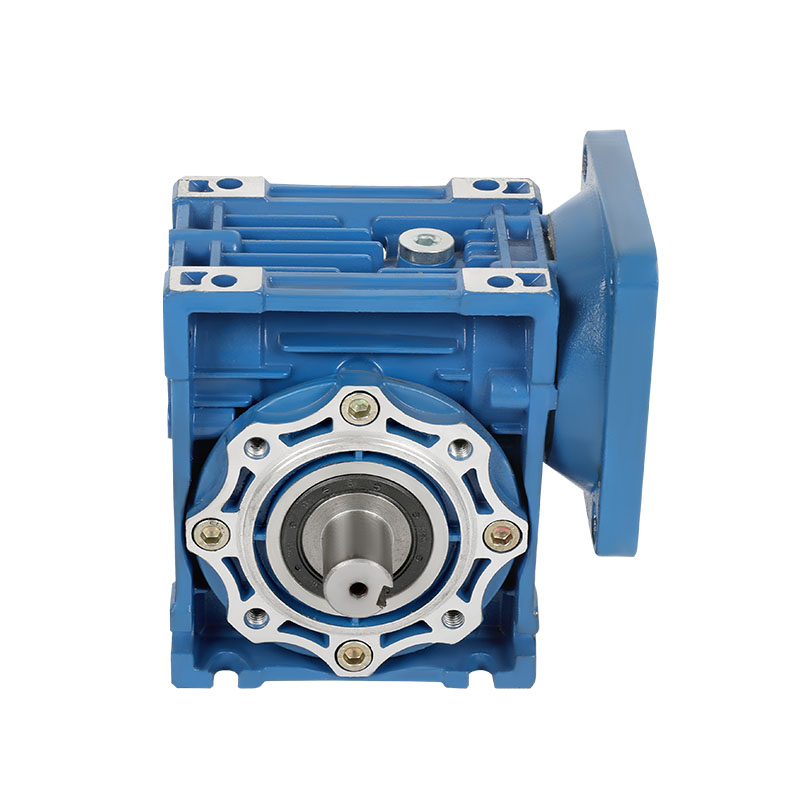RV worm gear reducers are widely used in various industrial fields due to their efficient deceleration performance, excellent load capacity and compact structural design. In order to meet the needs of different fields, RV worm gear reducers need to have strong adaptability and often require customized design.
Different application scenarios have different load characteristics and torque requirements for RV worm gear reducers, so they need to be customized according to specific load requirements.
For example, in wind turbines, RV worm gear reducers are often used to transmit large torques, and usually need to be designed with higher load capacity and stronger durability. To meet this demand, RV reducers need to use high-strength materials (such as alloy steel or high-strength cast iron) and undergo strict heat treatment processes to improve their wear resistance.
In fields such as robots or CNC machine tools that require high precision and low backlash, the customized design of RV reducers focuses on controlling backlash and improving transmission accuracy. It is usually necessary to use precision worm and worm processing technology (such as grinding) and use precision matching bearings to reduce errors in motion.
In some equipment with strict space requirements, RV reducers need to be miniaturized to reduce size and weight, such as in automated transmission systems, medical equipment and other fields. At this time, the design of RV reducers needs to optimize the internal structure, adopt efficient reduction ratios and compact installation methods to ensure that the reducer can provide sufficient torque output in a limited space.
The external protection design of RV worm gear reducers is particularly important in different working environments, especially in harsh working environments. According to the environmental characteristics of the application, the customized design of reducers often differs in the following aspects:
In some applications, such as offshore platforms and mining equipment, reducers need to have high dust and water resistance to prevent dust, moisture and corrosive substances from damaging the inside of the reducer. At this time, RV reducers need to adopt a higher protection level (such as IP65, IP67 level), and use sealing design to ensure that internal components are not affected by external factors.

Equipment working in high or low temperature environments, such as the metallurgical industry and petrochemical industry, requires reducers to have good temperature adaptability. At this time, the RV reducer may need to use high-temperature or low-temperature resistant materials (such as high-temperature resistant grease, corrosion-resistant alloy materials), and optimize the heat dissipation design to ensure that the reducer can work stably under extreme temperatures.
In highly corrosive working environments (such as marine engineering and chemical industries), reducers need to pay special attention to corrosion-resistant design. The corrosion resistance of the reducer can usually be enhanced by using stainless steel housings, electroplating anti-corrosion layers or coating technologies.
Different applications have different requirements for reduction ratios, speeds, output accuracy, etc. Customized reduction ratios and transmission accuracy are important directions for RV reducer design.
In some precision equipment, RV worm gear reducers need to be customized according to the specific requirements of the transmission system to provide different reduction ratios. For example, in robots and automation equipment, a small reduction ratio (such as 1:10 to 1:50) is usually required to achieve high-speed and precise control; while in wind turbines or mining machinery, a larger reduction ratio (such as 1:1000 and above) may be required to withstand large torques and achieve low-speed stable operation.
In high-precision application scenarios, such as CNC equipment, precision instruments, etc., RV reducers need to have extremely low backlash and high transmission accuracy. This requires the use of high-precision processing technology when designing the reducer to ensure that the meshing error between the worm and the worm wheel is minimized, thereby providing precise transmission performance.
RV worm gear reducers often generate large noise and vibration during operation, especially when running at high speeds. Therefore, noise control and vibration suppression are the focus of design in some application fields.
For some noise-sensitive applications, such as automation equipment, conveying systems, and medical equipment, special consideration should be given to the noise control of the reducer. The meshing accuracy of the worm wheel and worm of the reducer, the lubrication method, and the tooth shape optimization will have an important impact on the noise level. In order to reduce noise, high-precision gear processing, high-quality lubricating oil or grease, and optimization of the tooth shape of the worm and worm wheel are often used in the design.
The RV worm gear reducer can provide efficient and precise reduction transmission in many fields through its unique structural advantages. The adaptability and customized design of the RV reducer play a vital role in modern industrial applications.

 English
English русский
русский bahasa Indonesia
bahasa Indonesia
